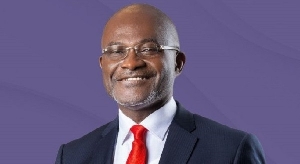- Home - News
- TWI News | TV
- Polls
- Year In Review
- News Archive
- Crime & Punishment
- Politics
- Regional
- Editorial
- Health
- Ghanaians Abroad
- Tabloid
- Africa
- Religion
- Election 2020
- Coronavirus
- News Videos | TV
- Photo Archives
- News Headlines
- Press Release
Business News of Thursday, 23 August 2012
Source: Kim Polley
Ghana: Macro update
- Rising macro risks increase upside risk to rates
* Fiscal slippage, largely due to wage costs. Ghana has a history of
running up bigger-than-targeted budget deficits in elections years,
particularly in the post-military-rule period (see Figure 1). The only
exceptions are 2000 and 2004, the year before Ghana qualified for debt
relief, 2005, when the authorities worked hard on narrowing the deficit to
improve the country's prospects. One of the country's worst fiscal
slippages was during the last election in 2008, when the outgoing New
Patriotic Party (NPP) government ran up a budget deficit of 8.5% of GDP,
which was significantly bigger than the target of 2-3% (under the rebased
GDP). The current National Democratic Congress (NDC) administration, which
inherited a large fiscal deficit, was compelled to adopt a fiscal
consolidation policy. The NDC administration managed to narrow the deficit
until 2011, when the budget deficit came in at 4.4% of GDP, below the
target of 5.1%. Given the below-target deficit of 2011 and the NDC
administration's fiscal consolidation credentials, our expectation was
that fiscal spending in 2012 would be contained, the fiscal slippage would
be minimal and the budget deficit would be close to the target of 4.8% of
GDP. However, in July, Finance Minister Kwabena Duffour proposed a
supplementary budget of GHS2.6bn ($1.34bn) that would allow for an
increase in spending of 1.9% of GDP and a wider budget deficit of 6.7% of
GDP. According to our estimates, 60% of the supplementary budget will go
towards the migration of public sector workers to the single spine salary
structure, and the implementation of the base pay increase of 18%. Twelve
per cent will go towards debt service costs and 11% to cover the
government's under-recovery of fuel and utility costs. The upside is that
public sector workers' migration to the new salary structure is near
complete, which should ease future wage cost increases.
* Weak cedi partly reflects financial outflows. Ghana's gross
international reserves declined by $1.1bn in 5M12 to $4.3bn or 2.5 months
of import cover in May, from $5.4bn or c.4 months of import cover at YE11.
Typically, economies with import cover of less than three months are
considered to be vulnerable to external shocks, such as a sharp increase
in the oil price. We think the sharp decline in Ghana's FX reserves is
partly due to the widening of the trade deficit in 5M12 by 57% to $937mn,
owing to a high international oil price that inflated the import bill and
lower-than-expected oil export volumes that undermined export earnings. We
expect this to have contributed to the widening of the current account
(C/A) deficit during this period, in addition to the increase in services
and income payments, which comes with the new oil industry. However, we do
not think a wider CA deficit alone explains the surge in the balance of
payments deficit of $1.3bn (11.9% of GDP) in 1Q12, from $154mn (1.7% of
GDP) a year earlier, when annualised, and the drop in FX reserves (see
Figure 2). We are of the view that financial outflows increased
significantly during this period, particularly short-term money. While we
had expected an increase in financial outflows as the December elections
approached, we had not anticipated them to begin so early in the year. The
subsequent drop in FX reserves explains the 20% depreciation of the
Ghanaian cedi in 7M12 to GHS1.96/$1. In order to stem what the Bank of
Ghana (BoG) viewed as speculative activity in the interbank FX market that
was exacerbating GHS weakness, the BoG implemented measures that would
ultimately stem cedi weakness, including hiking the policy rate by 250
bpts YtD, reducing the limits on net open FX positions of banks,
reintroducing BoG bills to provide additional avenues of cedi investment,
revising the application of the statutory reserve requirement so that
banks would need to maintain the mandatory 9% reserve requirement on
domestic and foreign liabilities in cedis only, and requiring all banks to
provide 100% cedi cover for their offshore account balances - to be
maintained at the BoG. We have noted the retracement of the cedi to
1.94/$1 from mid-August, suggesting that a combination of the
aforementioned policies may be taking effect. However, as it is still a
few months to elections, we project some further weakness to GHS2.0/$1 at
YE12.
* Downwardly sticky inflation. The acceleration of Ghana's inflation
has been significantly slower than we had expected (see Figure 3).
Headline inflation increased to 9.5% YoY in July, from 8.4% YoY a year
earlier, despite the cedi's 30% depreciation against the dollar over the
same period, to GHS1.96/$1. Yes, low food inflation has helped keep
headline inflation in the single-digit region. However, food inflation
also has edged up over the past 12 months, to 5.8% YoY in July, from 3.3%
YoY a year earlier. That said, we expected most of the inflationary
pressure to stem from non-food items, particularly from housing and
utilities' costs and transport prices, owing to particularly high oil
prices in 1Q12, and from clothing and furnishings, given that a
significant share of these goods are imported. However, non-food inflation
only increased to 12.4% YoY in July, from 11.3% YoY at YE12. All this
points to downwardly sticky inflation, which has delayed its return to the
double-digit region, in our view. We think a more stable cedi in 2H12, on
the back of the raft of policy measures that the BoG implemented in 1H12,
is positive for the inflation outlook; however, we still expect inflation
to rise into the low double-digit region by YE12, due to the proposed
increase in government spending and base effects.
* Pre-emptive rate hike likely. The BoG's 250-bpt hike of the policy
rate in 1H12 to 15% (see Figure 4) was largely intended to stem cedi
weakness. Although the cedi may have stabilised and retraced since 8
August, we still think the risk of a weakening cedi is significant as we
approach the YE12 elections. Along with inflationary pressures from an
increase in government spending in the order of 2% of GDP and strong
credit growth of 39.4% YoY in May (see Figure 5), compared to 18.5% YoY a
year earlier, this implies to us that the risk to inflation is definitely
to the upside. We think these factors will compel the BoG's monetary
policy committee to tighten by 50 bpts to 15.5% when it next meets on 12
September.
If you have any questions or comments regarding this report, please
contact me
you can access the attachment files at this location:
Ghana-Budget_inflation_rates-200812.pdf
Web Bug from
http://www.rencap.com/eng/research/morningmonitors/stimage.jpe?SEC=1&ITEMI
D=31925&File=pictures\empty.jpg&EMail=1&TEMP=0736A58F-6BA7-4E75-88DF-BE09F
EFD371D&Rnd=0.3171285
from
http://research.rencap.com/eng/stimage.jpe?SEC=1&ITEMID=31925&File=images\
empty.jpg&Rnd=0.3892329&EMail=1&TEMP=0736A58F-6BA7-4E75-88DF-BE09FEFD371D










